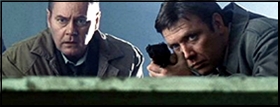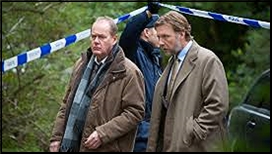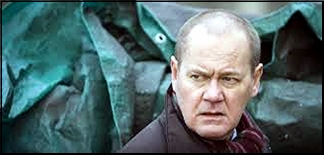Fri 25 Oct 2019
Music I’m Listening To: SINNE EEG “Comes Love.”
Posted by Steve under Music I'm Listening To[2] Comments
Here is Danish jazz vocalist Sinne Eeg singing with the Bergen Big Band, a great combination:
Fri 25 Oct 2019
Here is Danish jazz vocalist Sinne Eeg singing with the Bergen Big Band, a great combination:
Thu 24 Oct 2019
HUGH B. CAVE “The Late Mr. Smythe.” Short story. Peter Kane #1. First published in Dime Detective Magazine, August 1, 1934. Collected in Bottled in Blonde (Fedogan & Bremer, hardcover, 2000) and The Complete Cases of Peter Kane (Altus Press, 2018; introduction by Bob Byrne).
Private eyes in detective fiction are as often as not hard drinkers, and some of them are awfully good at it. But few of them are as good at it as was Peter Kane. There isn’t a single minute in “The Late Mr. Smythe” in which he isn’t totally sozzled. I can’t believe that anyone could go through life the same way he does, in three stages: drunk, drunker, and completely plastered.
A former member of the Boston police department, Kane nominally now works for the Beacon Detective Agency, but in “The Late Mr. Smythe,” he takes the death of a friend of his still on the force personally, and he works full time on this one on his own to bring the killer(s) to justice.
The first death is that of a blackmailer named Smiley Smythe, and when a cop named Hoban tries to bring his suspected killer in, a hoodlum named Joe DiVina, both men are killed by a torrent of machine gun fire from a car that comes speeding by.
Besides Kane, who spends a lot of time at a bar run by a fellow named Limpy, the other recurring characters are Moe Finch, the hapless chief of police, who continually begs for Kane’s assistance; and Kane’s nemesis still on the force, Lt. Moroni. It is always Kane’s pleasure to not only solve the case at hand, but to show up Moroni as well, and in the most dramatic way he can.
Hugh B. Cave is best known for his tales of horror and weird menace, but in this, the first of Peter Kane’s cases on record, he shows he could write very very good detective stories too. Surprisingly good, given Peter Kane’s way with either a glass or the bottle.
The Peter Kane series —
The Late Mr. Smythe. Dime Detective Magazine Aug 1 1934
Hell on Hume Street. Dime Detective Magazine Nov 1 1934
Bottled in Blonde. Dime Detective Magazine Jan 1 1935
The Man Who Looked Sick. Dime Detective Magazine Apr 1 1935
The Screaming Phantom . Dime Detective Magazine May 1 1935
The Brand of Kane. Dime Detective Magazine Jun 15 1935
Ding Dong Belle. Dime Detective Magazine Aug 1941
The Dead Don’t Swim. Dime Detective Magazine Nov 1941
No Place to Hide. Dime Detective Magazine Feb 1942
Thu 24 Oct 2019
W. L. RIPLEY – Storme Front. Wyatt Storme #2. Henry Holt, hardcover, 1995. Brash Books, paperback, 2005.
As I recall, my comment on the first of this series was “pretty good for what it is” — and what it was, was a typical Spenser/Hawk, Cole/Pike, etc., cowboy story. I seem to like the breed a little less each year, but I’ll still read ’em if they’re decently written, so —
Wyatt Storme, ex-Dallas Cowboy, Viet Nam vet, and semi-recluse, comes down off his Colorado mountain when an old college acquaintance inveigles him into acting as bodyguard on an illegal weapons deal by hinting at some danger to another old friend of Storme’s.
The deal goes bad and people are killed, but that’s just the start. Wyatt and his badass friend Chick Easton start looking for answers and find some that threaten not only them but Storme’s relaionship with his lover.
Well, Ripley still writes cowboy stories, and he still writes them well enough, and there’s not much more to say. He’s quite good on banter and one-liners, but that’s not really enough to carry a whole book. The wisecracking. brooding, semi-tragic hero and his lethal sidekick tak eon the bad guys, kick some righteous ass, kill a few people, and leave the world a better place for us all while the law watches admiringly and from a respectful distance.
It’s the masculine-machoequivalent of a good cozy, decently done, basically silly, utterly forgettable.
The Wyatt Storme series —
Dreamsicle (1993) Reprinted as Hail Storme (2015)
Storme Front (1994)
Electric Country Roulette (1996) Reprinted as Eye of the Storme (2016)
Storme Warning (2015)
Wed 23 Oct 2019
PETER LOVESEY – The Circle. Inspector Henrietta “Hen” Mallin #1. Soho Crime, hardcover, June 2005; trade paperback, June 2006. First published in the UK by Little Brown & Co., hardcover, 2005.
There’s a lot to like in this one. The “circle” in the title refers to a group of would-be writers who meet monthly to read and critique each other’s books, a premise for a mystery novel that I think all of us can identify with, even if only from the outside. Lovesey makes some very deft jabs at each of the members’ dreams and aspirations, even with the obvious realization that he’s set them up as very easy targets.
A newcomer to the group, a parcel truck driver named Bob Naylor and a sometime poet (of doggerel, he says), joins too late to be present when a vanity publisher stops in to talk to the members of the group, but when he’s later found murdered, perhaps by one of those who work he praised too highly (and falsely), it is Bob as an outsider, who leads the ad hoc and totally amateur investigation that follows, needed to clear everyone’s name.
The police are also involved, but Inspector Hen Mallin does not show up until about halfway through, introduced very briefly (less than one page) by Lovesey’s other major detective figure, Peter Diamond. It is possible that Mallin made an appearance in one of Lovesey’s earlier novels, but this is the first time she has (most of) a book to herself. She’s a non-nonsense cigar-smoking kind of woman, and it’s enjoyable to see her put down some of her male colleagues who are often either in awe of her or more simply jealous of her success.
Through the first two-thirds of the book there is something to smile about, or even laugh out loud, on nearly every page. The humor quotient goes down drastically after that point, however. as the detective story gains more and more precedence. And as such, and this is another key to the first sentence of this review, what Lovesey accomplishes in this book is the best Agatha Christie ending to a non-Agatha Christie novel that I’ve read in a long time, bar none.
—
Bibliographic Note: The only other solo outing for Inspector Mallin so far is The Headhunters (2008). I plan to give it a try as soon as I can.
Wed 23 Oct 2019
BECK. Sweden, beginning 1997. 10 seasons to date (not consecutive). Peter Haber, Mikael Persbrandt. Based on the characters created by Maj Sjowall and Per Wahloo.

A few notes before going on with the review, the first being that much of the information on this series at IMDb is wrong. The series ran ten seasons (all available on Hulu), not six. (*) The 1997 series does not have the same cast as the one produced in 1993, and most of the episode descriptions are wildly wrong. It is not a series about “Martin Beck and his eccentric partner,†as IMDb suggests, and the story lines read as though they were written by someone with limited understanding of Swedish who didn’t have English subtitles. They sound like bad guessing based on badly translated TV Guide summaries.
Based on the series of books by the husband and wife writing team of Maj Sjowall and Per Wahloo, Beck follows a Stockholm based homicide squad in Sweden lead by Martin Beck (Peter Haber), a weary stodgy but gifted policeman with troubles at home, hypochondria, and resentment of the difficulty created by politics interfering with his investigations. Typically one of his detectives Lena Klingstrom (Stina Rautlein) formerly had an affair with and lived with Beck, but is now back on his team.

His top investigator Gunvald Larsson is given to overuse of violence and questionable tactics, and something of an attractive oaf in the books, here played by Mikael Persbrandt (Swedish televisions spy series Hamilton) as the most attractive character in the series, whose brutal tactics usually work though he runs afoul of Internal Affairs fairly often. Gunvald is jealous of his position on the team, often rude, sexist, and would be a total ass if Persbrandt wasn’t such a good actor and the writers obviously enthralled by actor and character. As is, he brings much needed charisma to the series and an antidote to Haber’s Beck’s pained expressions and sad sack existence.
As in the books the series is a police procedural, but beyond the name of the two main characters, once the second season passed, the episodes have little to do with Sjowall and Wahloo’s rather dark view of Sweden. (Wahloo was a Marxist -leaning journalist who weighs the books down a bit with his bleak view of his country and anything vaguely resembling Democracy.) A few episodes in the first two seasons reflect this, and Beck’s hypochondria emerges off and on over the course of the series, but the series presents a brightly lit colorful view of Sweden even when tackling serious issues (which it does well and regularly) like drugs, child abuse, government abuses, corporate crime, and the like.

The wealthy and powerful don’t fare all that well, so some of Wahloo’s Marxist philosophy still slips through. By the by, I’m not being political, Wahloo was a well,known actual Marxist,leaning journalist highly critical of his homeland and the West. It’s how he was known before he began writing mystery novels. It’s not my opinion, it’s his own description of himself.
And while true to the books, the series spends far too much time on Beck’s tiresomely painful private life. Rebecka Hemse has a recurring role as his combative single-mother daughter Inger who in the most recent season is secretly seeing Larsson, who is twelve years older than her. Beck is not happy when he finds out.
Also filling out far too much of the time of the average 1 hour and 25 minute episode (many episodes were released as movies) is Beck’s annoying neighbor, or “Grannen” (Ingvar Hirdwall), who is not only eccentric, but insulting, casually racist, and boring as hell. Maybe I just don’t understand the Swedish sense of humor, but I clearly don’t get this guy who seems to have wandered in from a bad episode of Seinfeld.
But aside from that character, the actors are good with Haber (not my idea of Beck at all) quite good, and Persbrandt far more charismatic than the books ever imagined Gunvald.
Episodes are good, they just aren’t Martin Beck, at least not Sjowall and Wahloo’s Martin Beck. Some of them are very good though.
“The Japanese Print†from the most recent season is a good example. Hans Sperbling is a grossly obese German policeman who has assisted Beck in Germany in the past; he’s pretty much Germany’s Beck. He has come to Stockholm quietly to bid at an art auction on a rare signed Shunga period erotic print, which he loses out to an attractive woman who identifies herself as an art agent and offers him first look at some Shunga prints and Marc Chagall prints she has in her room later that evening.

When she doesn’t show up he goes upstairs at the hotel and finds her room open. He calls his friend Martin Beck and together they find her murdered, posed like a well known Chagall print “Woman on Bed of Rosesâ€, and the prints gone.
Gunvald doesn’t much trust his boss’s German friend, who despite Beck’s protests has to stay during the investigation. There are two more murders each a tableau mordant copying works of art.
Meanwhile Beck’s grandson drops the bomb that Gunvald is dating Inger.
The investigation leads to dealers who fix low prices at auctions illegally as well as a series of fake Chagall prints made from the original color lithographic stones that were supposed to have been destroyed. It turns out to be a multi million dollar scam and ends with Sperbling and Gunvald teamed in what works out to be a pretty good Nero Wolfe/Archie Goodwin vibe before going a bit melodramatic at the end with a wealthy mad collector and his armed henchmen.

To be honest, the fat German and Gunvald are a more interesting team than Beck and Gunvald.
The series shown on Hulu is subtitled, but this particular episode includes long sequences in English, and most episodes have some English language dialogue.
Other than Beck’s neighbor and private life, the usual problems with series television apply. Far too many episodes end in gunfire, far too often the criminal is brought in out of thin air, and more often than is good for the series, the protagonists somehow manage to get “revenge†on the bad guy. Almost none of those problems were true to the books, which were often clever, and I suspect not to the 1993 episodes often based on the novels.

Other than the climate, there is nothing very Swedish about the series. The plots are mostly clever and well done, acting good, and writing above average, but they could be set in any large Western capital in any country and any language, and you wouldn’t notice much of a change, a reminder that Walter Matthau and Bruce Dern played Beck and Gunvald in the Americanized film of The Laughing Policeman.
—
(*) IMDB says six seasons, but lists episodes since 1997 with breaks of several years between episodes over the years, the last in 2018. Wikipedia has seven seasons, but Hulu lists the series as ten seasons as did MHv where the series was also shown. I would tend to suspect both IMDb and Wikipedia haven’t been updated since they were written.

Tue 22 Oct 2019
THEODORE STURGEON “The Ultimate Egoist.” Short story. First published in Unknown, February 1941. Collected in Without Sorcery (Prime Press, hardcover, 1949) and The Golden Helix (Dell, paperback, 1980; Carroll & Graf, paperback, 1989), among others. Reprinted in Human?, edited by Judith Merrill (Lion #205, paperback, 1954).
I suppose everyone, at one time or another, has had the following fantasy: that the world you see, and the objects in it, could disappear if you simply decided that they no longer existed. That the facade of life revolves around you and you only. You don’t even have to admit it. I know you have.
And such is the basis of this early story by master SF author Theodore Sturgeon. I think his work in the short story form was almost uniformly superb; in fact I think most of his readers would agree that his short fiction was a step above the relatively few novels he wrote in his lifetime (1918-1985). The only question is, from this basic premise, where does he go from here? The answer, the only way it could.
I think this story is a small gem, not a perfect one — later in his writing career, Sturgeon would have polished it up to even better effect — but even as is, it’s clever, alive, and a lot of fun to read. What more could you ask from a short tale that’s not far from everyone’s dreams?
Tue 22 Oct 2019
GEORGE (Adam) HERMAN (Jr.), born April 12, 1928; died in Portland, Oregon, on June 22, 2019.
GEORGE HERMAN has played many roles in his long career, including published poet and short- story writer, professional actor and director, theater critic and columnist, university professor, and award- winning playwright. His play, “Pious Nine Is Falling Down,” was awarded second place in the Beverly Hills Theatre Guild’s Julie Harris Playwright Competition.
From Goodreads:
The Leonardo da Vinci and Niccolo da Pavia series —
The series stars, as amateur sleuths, the unlikely duo of Leonardo da Vinci and a young dwarf, Niccolo da Pavia.
A Comedy of Murders (Carroll & Graf, 1994)
The Tears of the Madonna (Carroll & Graf, 1996)
The Florentine Mourners (iUniverse, 2000)
The Toys of War (iUniverse, 2001))
Necromancer (iUniverse, 2003)
The Arno Serpent (iUniverse, 2007).
Also by George Herman: Carnival of Saints (Ballantine, 1994).
Tue 22 Oct 2019
Mon 21 Oct 2019
MANHANDLED. Paramount Pictures, 1949. Dorothy Lamour, Sterling Hayden, Dan Duryea, Irene Hervey, Phillip Reed, Harold Vermilyea, Alan Napier, Art Smith, Irving Bacon. Screenplay by Lewis R. Foster & Whitman Chambers, based on the story “The Man Who Stole a Dream,” by L. S. Goldsmith. Director: Lewis R. Foster.
There are some positive aspects to this film, including an absolutely bravura performance by Dan Duryea, but sad to say, there aren’t enough of them for me to give you more than a very tepid recommendation that you see it, if you haven’t done so already. And that’s especially true if, attracted by either the title or the names of those in the cast, you’re expecting a solidly built film noir.
And a solidly built film noir is not what this is. Maybe the first ten minutes, in which we see a husband, obviously impatiently waiting for his wife to come home with her current boy friend or so he assumes, followed by an argument which culminated with in crashing a perfume bottle down on her head, killing her instantly.
It’s a chilling scene that’s beautifully photographed. It’s too bad, then, that it was all a dream, as the husband is next seen telling his psychiatrist all about it. The dream, that is. The doctor tries o alleviate the husband’s fears, but he also seems inordinately interested the wife’s jewelry, which are said to be worth something $100,000.
Which is a lot of money, then or now, and when the wife is subsequently found murdered, in identical fashion to the husband’s dream, of course the jewelry is missing. At which point the film shifts into its real reason for existing: a fairly ordinary murder mystery. Did the husband really do it, or if not, who else knew about the dream and jewelry? The doctor, of course, or perhaps the PI (Dan Duryea) who lives in the apartment immediately below the doctor’s secretary (Dorothy Lamour).
I have not yet mentioned Sterling Hayden, who plays the insurance investigator assigned to the case, and whose eye is quick to notice that the secretary is an extremely attractive woman. You’d also think he’d be more involved with solving the case as well, but in spite of many opportunity to do so, the story goes off in another direction altogether.
No, it’s Dan Duryea’s performance that carries the story, no doubt about it. He always played smooth but ultimately sleazy operators to the hilt, but in Manhandled he turns his trademarked unctuousness up a notch, or maybe three. A greater cad in all regards, you cannot imagine.
The movie does get a little rougher — especially in the final fifteen minutes — but after the one additional twist I thought was coming never materialized, I was so non-interested as not to care. This one could have been a lot better than it actually turned out.
PS. The orecurring attempts to add some humor, especially the police car with no brakes, were truly lame, indeed.
Mon 21 Oct 2019
ROBIN HATHAWAY “Does Thee Murder?” Short story. Dr. Andrew Fenimore. Short story. Published in Ellery Queen Mystery Magazine, March/April 2013.
Of the four Dr. Fenimore detective stories that are so indicated in the online Crime Fiction Index, this is number four. Between 1998 and 2006 author Robin Hathaway also wrote five full-length novels with Dr. Fenimore, none of which I’ve read.
This may have been a serious error on my part. I thought they were cozies, but on the basis of this particular story, at least, Dr. Fenimore is actually a very good amateur detective, and the mystery he tackles in “Does Thee Kill?” is a serious one.
In this tale an elderly woman, a devout Quaker, is attacked and killed while taking a walk near her isolated old mansion of a home, which has become isolated in a small neighborhood of Philadelphia that has been going downhill for several years. The police think it’s nothing more than a random mugging, but Dr. Fenimore wonders about it and decides to make some inquiries. If the police are wrong, he’d like to do something about it.
Besides following his investigation closely, the story includes a intimate description of what a Quaker funeral is like. Set in austere surroundings, the people congregated together there sit in silence until someone feels the urge to stand up and say something heartfelt about the deceased.
All of the characters are real people, and Fenimore’s detective work is solidly done. Of special note, the ending is most satisfactory. Other authors may have taken another page or so to include a complete explanation. It pleases me to say that Robin Hathaway did not believe she needed to, and she was right.